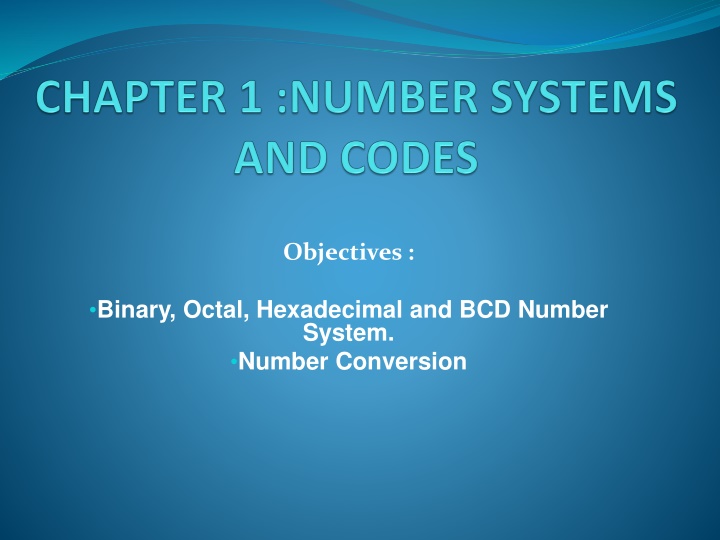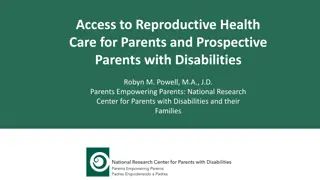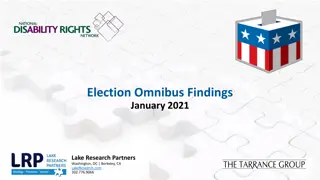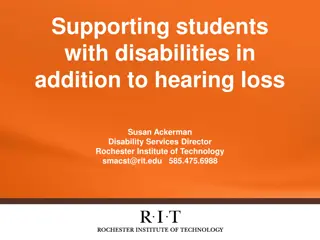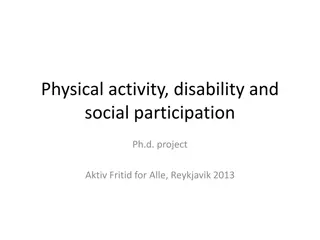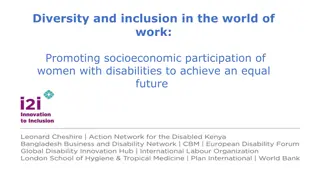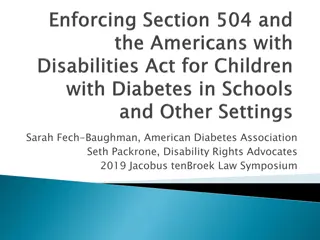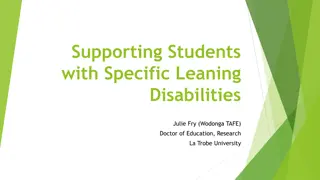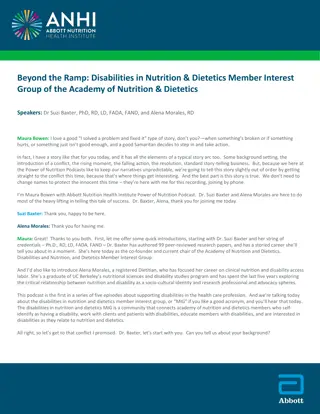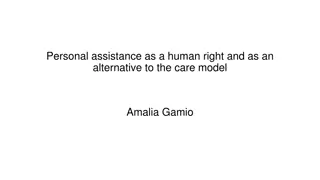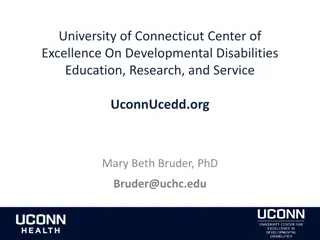Physical Disabilities
Physical disabilities resulting from orthopedic impairments or neurological conditions can impact an individual's movement, educational performance, and social integration. Learn about the characteristics of these disabilities and the special education services provided to support affected individuals.
Download Presentation

Please find below an Image/Link to download the presentation.
The content on the website is provided AS IS for your information and personal use only. It may not be sold, licensed, or shared on other websites without obtaining consent from the author.If you encounter any issues during the download, it is possible that the publisher has removed the file from their server.
You are allowed to download the files provided on this website for personal or commercial use, subject to the condition that they are used lawfully. All files are the property of their respective owners.
The content on the website is provided AS IS for your information and personal use only. It may not be sold, licensed, or shared on other websites without obtaining consent from the author.
E N D
Presentation Transcript
Objectives : Binary, Octal, Hexadecimal and BCD Number System. Number Conversion
Outcomes At the end of this chapter, students should be able to:- Differentiate between decimal, binary, octal, hexadecimal and BCD. Convert number between bases.
1.1 List of Number Type Base Numbers/Symbols Decimal 10 0, 1, 2, 3, 4, 5, 6, 7, 8, 9 Binary 2 0, 1 Octal 8 0, 1, 2, 3, 4, 5, 6, 7 Hexadecimal 16 0, 1, 2, 3, 4, 5, 6, 7, 8, 9, A, B, C, D, E, F
2.0 Binary Numbers Used to represent the voltage levels of a digital circuit. Only two voltage levels present in a digital circuit, logic High and logic Low. The high voltage is +5V and the low voltage is +0V. The binary numbers represent the logic low as a 0 and the logic high as a 1.
2.1 Binary Numbers Example A calculator is an example of a digital system. Decimal numbers are pressed on the keypad, where the input values are converted to binary for processing, then converts the answers to a decimal value before displaying them. Number conversion occurs extensively in a digital circuit. In this chapter, you will learn numbers systems and codes used in digital circuit. You will also learn how to perform conversion from one number system to another.
2.2 Decimal Binary Conversion A decimal number can be converted to a binary number by successively dividing the number by 2 as follows: Note that the first remainder becomes the most significant bit (MSB). The last remainder becomes the least significant bit (LSB).
2.3 Binary Decimal Conversion A binary number is converted to a decimal number by summing together the weights of various positions in the binary number which contain a 1. For example, 10101112 = 8710.
3.0 Decimal Octal Conversion A decimal number can be converted to an octal number by successively dividing the number by 8 as follows: 266 8 = 33 remainder 2 LSD (right-most digit) 33 8 = 4 remainder 1 4 8 = 0 remainder 4 MSB (left-most digit). Therefore 26610 = 4128
3.1 Octal Decimal Conversion To convert an octal number to a decimal number, multiply each octal value by the weight of the digit and sum the results. For example, 4128= 26610.
3.2 Octal Binary Representation Each octal digit can be represented by a 3-bit binary number as shown below:
3.3 Octal Binary Conversion Conversion from octal to binary is very straightforward. Each octal digit is replaced by 3-bit binary number. For example, 4728 = 100 111 0102. A binary number is converted into an octal number by taking groups of 3 bits, starting from LSB, and replacing them with an octal digit. For example, 11 010 1102 = 3268.
4.0 Hexadecimal Number The hexadecimal number uses base 16. It uses the digits 0 through 9 plus the letters A, B, C, D, E and F. The letter A stands for decimal 10, B for 11, C for 12, D for 13, E for 14 and F for 15.
4.2 Decimal Hexadecimal Conversion A decimal number can be converted to hex number by successively dividing the number by 16 as follows:
4.3 Hexadecimal Decimal Conversion To convert a hex number to a decimal number, multiply each hex value by the weight of the digit and sum the results. For example, 1A716 = 42310.
4.4 Hexadecimal Binary Conversion Each hex digit can be represented by a 4-bit binary number as shown above. Conversion from hex to binary is very straightforward. Each hex digit is replaced by 4-bit binary number. A binary number is converted into an octal number by taking groups of 4 bits, starting from LSB, and replacing them with a hex digit. For example, 110101102 = 3268.
5.0 Binary-Coded-Decimal (BCD) Conversions between decimal and binary can become long and complicated for large numbers. For example, convert 87410 to binary. The answer is 11011010102, but it takes quite a lot of time and effort to make this conversion. We call this straight binary coding.
5.1 Binary-Coded-Decimal (BCD) The Binary-Coded-Decimal (BCD) code makes conversion much easier. Each decimal digit, 0 through 9, is represented with a 4-Bit BCD code as shown below. The BCD code 1010, 1011, 1100, 1101, 1110 and 1111 are not used.
5.2 Decimal BCD Conversion Conversion between BCD and decimal is accomplished by replacing a 4-bit BCD for each decimal digit. For example, 87410= 1000 0111 0100BCD. BCD is not another number system like binary, octal, decimal and hexadecimal. It is in fact the decimal system with each digit encoded in its binary equivalent. A BCD code is not the same as a straight binary number. For example, the BCD code requires 12 bits, while the straight binary number requires only 10 bits to represent 87310.
5.3 BCD Decimal Conversion A BCD code is converted into a decimal number by taking groups of 4 bits, starting from LSB, and replacing them with a BCD code. For example, 1 1001 0111 1000 BCD = 197810
Exercises 1. Convert decimal 23410 to a. binary b. BCD b. octal c. hexadecimal 2. Convert binary 10010111012 to a. decimal b. octal c. hexadecimal d. BCD
Exercises 3. Convert hexadecimal ABF216 to a. decimal b. binary c. octal d. BCD 4. Convert BCD 10010100100110001BCD to a. decimal b. octal c. hexadecimal d. binary 5. Convert number octal 5268 to a. decimal b. BCD c. hexadecimal d. binary
6.0 Base Conversion for Floating Points with the Remainder Method Decimal Binary Eg. Convert 23.37510 to base 2. Technique: 1. Start by converting the integer portion:
6.0 Floating Points Conversion using Remainder Method Decimal Binary 2. Then, convert the fraction by multiply it with the based we want to convert: IF ZERO, THEN STOP
6.0 Base Conversion for Floating Points with the Remainder Method Binary Decimal Eg. 1010.012 = _________ 10 Technique: Multiply each binary number by 2-n, where -n is the weight of the bit for fraction starting from left to right. . Then, sum the results. 1010.012 = 1 x 23 + 0 x 22 + 1 x 21 + 0 x 20 . 0 x 2-1 + 1 x 2-2 = 10 + 0.25 = 10.25 10 Therefore, 1010.012 = 10.2510
6.0 Base Conversion for Floating Points with the Remainder Method Octal Decimal Technique: Multiply each octal number by 8-n, where -n is the weight of the bit for fraction starting from left to right. . Then, sum the results. Eg. 46.38 = _________ 10 46.38 = 4 x 81 + 6 x 80 + 3 x 8-1 = 38 + 0.375 = 38.375 10 Therefore, 46.38 = 38.37510
6.0 Base Conversion for Floating Points with the Remainder Method Hexadecimal - Decimal Technique: Multiply each hexadecimal number by 16-n, where -n is the weight of the bit for fraction starting from left to right. Then, sum the results. Eg. A7.0F16 = _________ 10 A7.0F16 = 10 x 161 + 7 x 160 + 0 x 16-1 + 15 x 16-2 = 167 + 0.059 = 167.059 10 Therefore, A7.0F16 = 167.05910
Exercises 1. Convert the following number to the indicated base/code. a) b) c) d) e) 11101.112 to decimal. FED.4716 to octal. 01101001BCD to binary. 7548 to BCD. 152.2510 to hexadecimal. FED.47 8421 1111 1110 111 111 101 101.010 0 01 110 7 7 5 5. 2 1 6 7755.216 1101.10000000 98.4 010 011 000.010 000 230.20
